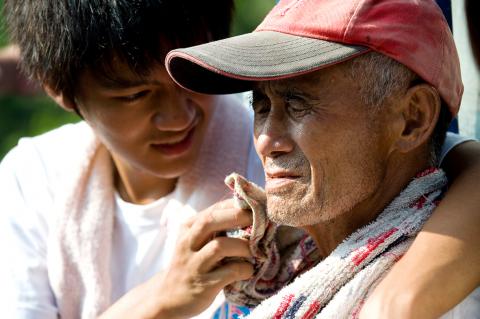For her debut feature Finding Sayun (不一樣的月光), Atayal director Chen Chieh-yao (陳潔瑤) returns to her home village to unearth the legend of Sayun (sometimes spelled Sayion), an Atayal girl who fell to her death in a turbulent stream while carrying a Japanese teacher’s belongings at the end of World War II.
Whereas Wei Te-sheng’s (魏德聖) big-budgeted Seediq Bale (賽德克.巴萊) tackled Aboriginal history in the form of battle epic, Chen (or Laha Mebow in Atayal) takes a completely different approach, examining her Aboriginal roots through personal memories and scenes from everyday life.
The movie begins when the tale of Sayun draws a television crew to the Atayal hamlet of Tyohemg (金岳) in Nanao Township (南澳), Yilan County. Yukan (Tsao Shih-hui, 曹世輝), a high-school boy and a young hunter, does not understand the crew members’ interest in the story. But his grandfather’s (Chang Chin-chen, 張金振) memories of Sayun, whom he went to school with, revives his interest in the old tribal village, which the villagers had been forced to desert 50 years prior.

Photo courtesy of Sky Films Entertainment
The grandfather wants to pay a visit to his childhood home, and Yukan is determined to fulfill the old man’s wish. One day at dawn, together with Yukan’s friend A-guo (Cheng Chia-yeh, 鄭嘉業) and Hsiao-ju (Fang Chih-yu, 方志友) from the crew, they embark on a journey along the treacherous trail to the Atayal home.
Shot entirely in and around the Atayal village and with a cast of mostly nonprofessional, Aboriginal actors, the film is director Chen’s sincere attempt to reconnect with her roots. She delivers a refreshing, lively portrait of Aborigines, who are often depicted as miserable and depressed in films such as Everlasting Moments (靈魂的旅程). Lin Ching-tai (林慶台), who plays Mouna Rudo in Seediq Bale, returns in this movie to his real-life profession (he’s a pastor) and the young Atayal actors give confident performances.
To be honest, Finding Sayun is a debut effort with many flaws. Its storytelling is uneven, and the decision to insert two irrelevant Chinese characters — in order to woo Chinese investors perhaps? — is awkward. Moreover, the film can be fairly confusing to audience members unfamiliar with the legend of Sayun.

Photo courtesy of Sky Films Entertainment
The significance of the story surfaces only if one knows how Japanese colonialists used it for propaganda purposes, the fact that director Chen’s grandmother was Sayun’s classmate and friend, and how the late banker Lin Keh-hsiao (林克孝) kindled public interest in the village when he wrote a book in 2009 about his years investigating the story of Sayun.
Still, Chen knows that there is more than one way to look at history, and uses documentary footage to show how differently the story is remembered by the villagers she interviews. In the end, Finding Sayun is the director’s journey of finding her own way home as she follows the 77-year-old tribal elder Chang to the place where her grandparents were born and the ancestral spirits still dwell.

Photo courtesy of Sky Films Entertainment

June 23 to June 29 After capturing the walled city of Hsinchu on June 22, 1895, the Japanese hoped to quickly push south and seize control of Taiwan’s entire west coast — but their advance was stalled for more than a month. Not only did local Hakka fighters continue to cause them headaches, resistance forces even attempted to retake the city three times. “We had planned to occupy Anping (Tainan) and Takao (Kaohsiung) as soon as possible, but ever since we took Hsinchu, nearby bandits proclaiming to be ‘righteous people’ (義民) have been destroying train tracks and electrical cables, and gathering in villages

This year will go down in the history books. Taiwan faces enormous turmoil and uncertainty in the coming months. Which political parties are in a good position to handle big changes? All of the main parties are beset with challenges. Taking stock, this column examined the Taiwan People’s Party (TPP) (“Huang Kuo-chang’s choking the life out of the TPP,” May 28, page 12), the Democratic Progressive Party (DPP) (“Challenges amid choppy waters for the DPP,” June 14, page 12) and the Chinese Nationalist Party (KMT) (“KMT struggles to seize opportunities as ‘interesting times’ loom,” June 20, page 11). Times like these can

Dr. Y. Tony Yang, Associate Dean of Health Policy and Population Science at George Washington University, argued last week in a piece for the Taipei Times about former president Ma Ying-jeou (馬英九) leading a student delegation to the People’s Republic of China (PRC) that, “The real question is not whether Ma’s visit helps or hurts Taiwan — it is why Taiwan lacks a sophisticated, multi-track approach to one of the most complex geopolitical relationships in the world” (“Ma’s Visit, DPP’s Blind Spot,” June 18, page 8). Yang contends that the Democratic Progressive Party (DPP) has a blind spot: “By treating any

Swooping low over the banks of a Nile River tributary, an aid flight run by retired American military officers released a stream of food-stuffed sacks over a town emptied by fighting in South Sudan, a country wracked by conflict. Last week’s air drop was the latest in a controversial development — private contracting firms led by former US intelligence officers and military veterans delivering aid to some of the world’s deadliest conflict zones, in operations organized with governments that are combatants in the conflicts. The moves are roiling the global aid community, which warns of a more militarized, politicized and profit-seeking trend